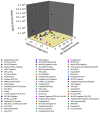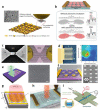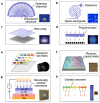Integrated Graphene Heterostructures in Optical Sensing
- PMID: 37241683
- PMCID: PMC10224136
- DOI: 10.3390/mi14051060
Integrated Graphene Heterostructures in Optical Sensing
Abstract
Graphene-an outstanding low-dimensional material-exhibited many physics behaviors that are unknown over the past two decades, e.g., exceptional matter-light interaction, large light absorption band, and high charge carrier mobility, which can be adjusted on arbitrary surfaces. The deposition approaches of graphene on silicon to form the heterostructure Schottky junctions was studied, unveiling new roadmaps to detect the light at wider-ranged absorption spectrums, e.g., far-infrared via excited photoemission. In addition, heterojunction-assisted optical sensing systems enable the active carriers' lifetime and, thereby, accelerate the separation speed and transport, and then they pave new strategies to tune high-performance optoelectronics. In this mini-review, an overview is considered concerning recent advancements in graphene heterostructure devices and their optical sensing ability in multiple applications (ultrafast optical sensing system, plasmonic system, optical waveguide system, optical spectrometer, or optical synaptic system) is discussed, in which the prominent studies for the improvement of performance and stability, based on the integrated graphene heterostructures, have been reported and are also addressed again. Moreover, the pros and cons of graphene heterostructures are revealed along with the syntheses and nanofabrication sequences in optoelectronics. Thereby, this gives a variety of promising solutions beyond the ones presently used. Eventually, the development roadmap of futuristic modern optoelectronic systems is predicted.
Keywords: integrated graphene heterostructure; optical sensing; optical waveguide; perspective; plasmonic; spectrometer; synaptic system.
Conflict of interest statement
The authors declare no conflict of interest.
Figures













References
-
- Rogalski A., Kopytko M., Martyniuk P. 2D Material Infrared and Terahertz Detectors: Status and Outlook. Opto-Electron. Rev. 2020;28:107–154.
-
- Liu R., Wang F., Liu L., He X., Chen J., Li Y., Zhai T. Band Alignment Engineering in Two-Dimensional Transition Metal Dichalcogenide-Based Heterostructures for Photodetectors. Small Struct. 2021;2:2000136. doi: 10.1002/sstr.202000136. - DOI
-
- Aamir Iqbal M., Malik M., Khac Le T., Anwar N., Bakhsh S., Shahid W., Shahid S., Irfan S., Al-Bahrani M., Morsy K., et al. Technological Evolution of Image Sensing Designed by Nanostructured Materials. ACS Mater. Lett. 2023;5:1027–1060. doi: 10.1021/acsmaterialslett.2c01011. - DOI
Publication types
LinkOut - more resources
Full Text Sources
Miscellaneous

